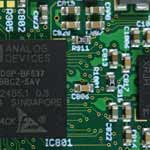Digital Signal Processing
 Taking over more and more tasks formerly handled by analog circuits, Digital Signal Processors (DSPs) serve as the working horse of modern communication devices as modems, mobiles, CD- and DVD player and recorders, receiver for digital radio, digital TV sets and graphics cards. For many important domains DSPs are providing much more power for less money than complex multi-purpose processors in personal computers do.
Taking over more and more tasks formerly handled by analog circuits, Digital Signal Processors (DSPs) serve as the working horse of modern communication devices as modems, mobiles, CD- and DVD player and recorders, receiver for digital radio, digital TV sets and graphics cards. For many important domains DSPs are providing much more power for less money than complex multi-purpose processors in personal computers do.
DSPs at telos
telos has recognized the importance of signal processors very early. For a couple of years telos has been developing customer-specific applications for DSPs. We use both traditional and multi DSP architectures as e.g. Philips’ TriMedia and also DSPs provided by manufacturers like ARM, Intel or Freescale. Beyond this we often work with manufacturers, who desire application software development in parallel to their prototype DSP hardware development. In this case, software often must be developed using simulators and/or emulators. This software must be conferrable to the real hardware with less adaptions later.
The following list gives a small selection of the range of application in which telos used DSPs during projects:
- implementation of speech coding standards like CELP
- implementation of MPEG audio and video de-/compression
- creation of miscellaneous next generation audio 5.1 surround systems
- development of interface connections for communication systems connected to world wide transmission channels
Digital Audio, Digital Video
Especially the processing of digital audio and video signals causes a great amount of data. In order to process, transmit and store those data in an efficient way, powerful hardware architecture is necessary using intelligent, adaptive algorithms which must be developed to filter, convert and compress media data. These algorithms usually should be capable of real-time processing.
The latest DSP architectures, which are especially designed for sophisticated signal processing, consisting of fast arithmetic units (ALU), internal buses for parallel processing and multi-standard interface systems. These chip cores are best qualified for most of the actual and future tasks in signal processing development.
Softwaredevelopment For DSPs
Software development indeed has changed a lot during the last years.
In the past, programming was limited for a long period of time to the use of the assembler programming language, which often needed to be optimized manually. Effective programming then needed a deep knowledge about the chip architecture and the algorithms to be developed.
Nowadays, the standard language “C” is more and more provided by many chip manufacturers for their DSP families. This high level language supports the developer in optimizing the code. So most manufacturers provide the extended programming language “DSP-C”. This improves the maintainability and reusability of the software and helps porting the code to other processors.
To assure the advantages of the optimizing language compiler, the software design must be controlled and regulated from the beginning of the development planning phase. This prevents from the risk of calculation overhead, which could reduce computing power and the capability of real-time processing.
Thus the requirements to DSP software development change from optimizing close-to-hardware programming to a complex software system design under the rules of given specifications and quality requirements.
To satisfy these alterations in software development telos uses an active and annually certified quality management system which controls the required software design right from the start.
Links
It is hard to find a good overview on DSP, but here is an outstanding one.
